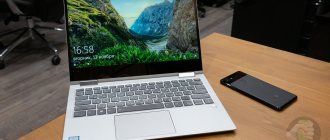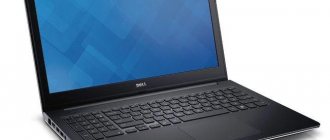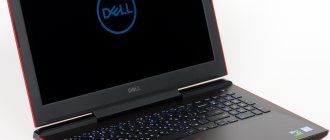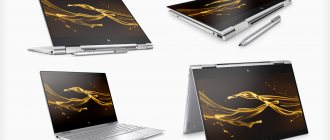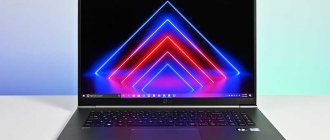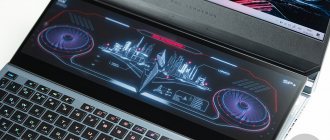XPS 15 9575 is the “top” solution in Dell’s consumer laptop line. This is a beautiful, lightweight and, at the same time, very powerful portable - let's not be afraid of these words - workstation for very serious tasks, including video editing and working with computer graphics. The laptop is very good; it is equipped with FHD/UHD touchscreen displays with excellent characteristics and at the same time it is also a transformer. It is this model that we want to talk about in detail today.
Appearance and ergonomics
One of the main features of the Dell XPS line of laptops is its recognizable design. It is absolutely impossible to confuse these computers with anything else. Wedge-shaped body, durable solid sheets of brushed aluminum top and bottom, and a carbon fiber work surface.
Everything together looks very beautiful and modern. And from a practicality point of view, this is good - on matte metal, fingerprints are not visible at all, but on black carbon, they are masked by a square texture.
The current version of the XPS 15 this year comes in two versions. The standard laptop is the XPS 15 9570. And the hero of today’s review is a transformer with the index 9575. Its display can be completely tilted back at 360 degrees. Two metal hinges securely fix the lid in almost any position chosen by the user, except perhaps the most minimal ones. The balance is also in order: if the gadget is on a table, then the lid will in no case outweigh the working part with the keyboard and tilt the entire structure backwards.
If you can find fault with anything, it’s only that you won’t be able to lift the lid with one hand. The hinges are quite tight, and you need to hold the working panel with your second hand. But it probably couldn’t be otherwise due to the very concept of a convertible laptop. Reliability of fixing the cover in the desired position is a priority.
In both versions of the 15-inch Dell XPS, the virtually frameless InfinityEdge display looks especially impressive. On the left, right and top, the gaps from the edges of the case to the beginning of the screen are not even 5 mm wide. There is more indentation at the bottom, because This is where the webcam is located. In general, it is this approach that has allowed Dell developers to create truly light and compact laptops for several years in a row.
The Dell XPS 13 9370, which we talked about in detail about a month ago, weighs 1.2 kilograms with a diagonal of 13 inches. The XPS 15 9575, with a noticeably larger screen, weighs 2 kilograms. Compared to the non-convertible 15-inch XPS 15 9570 and 9560, the weight of the reviewed model is only 200 grams more: the classic version of the laptop weighs 1.8 kg.
So the computer is very portable for its size, and in this respect it is one of the leaders in its class. If necessary, you can take such a laptop with you to work every day without much discomfort.
Interfaces
The Dell XPS 15 9575 is a 15-inch laptop, but it is quite thin: 16 mm at its thickest and 9 mm at its thinnest.
That is why it was not possible to place a single full-size USB port on its sides. USB Type-C rules the roost. On the left side of the computer there are two such interfaces with support for Thunderbolt 3, one of them also acts as a port for charging the computer, as indicated by the corresponding icon, but in general, any Type-C port can be used for this. There is also a microSD card reader (speed - about 140 megabytes per second) and an indicator of the remaining battery charge with an activation button. One small LED on - 20% of the battery capacity.
On the right side there are two more USB-C 3.1 with DisplayPort support. Nearby is a combined audio input and a connector for a Noble lock.
Obviously, buying a Dell XPS 15 9575 will require you to be confident in completely abandoning the old “thick” USB connectors. There is probably no doubt that sooner or later Type-C will conquer the world, but the process is still moving rather slowly and there is nothing left to do with this transition period other than just surviving it. The compact adapter from Type-C to Type-A included in the package will help in part. But if you plan to use a lot of different peripherals in your work, then it is, of course, better to immediately acquire a portable hub.
Autonomy
The Dell XPS 15 version in question is equipped with a 56 Wh battery (4666 mAh, 13.5 V). This battery was enough for almost 10 hours of laptop operation in reading mode. In the classic mode of the Battery Eater Classic application, the laptop worked for 2.5 hours before being discharged. In this case, you can count on approximately 5-6 hours of active office work. During gaming loads, the battery reserves are depleted in a little over an hour.
The Dell XPS 15 modification, equipped with a Core i7 processor, as well as a 4K resolution screen and a capacious SSD, is offered with an 84 Wh battery.
The laptop comes complete with a 130 W (19.5 V; 6.67 A) power supply. Considering the TDP of the processor and discrete video card, such a block does not seem redundant. In addition, it is very compact for its power.
The power supply connector has a white LED indicating the connection of the unit to the network.
The start of charging is indicated by an indicator on the front edge of the laptop. It takes a little over 2 hours to fully charge the laptop. In this case, you can even charge the battery via USB-Type C, but obviously this will take more time.
4.5
ITC.UA rating
Pros: Stylish, elegant design; high quality of materials and workmanship; compact body; very thin display frame; high-quality screen; USB Type-C port with support for USB 3.1 and Thunderbolt 3; keyboard backlight; good CPU/GPU balance
Cons: High price; modification without SSD; heating under high load
Conclusion: The Dell XPS 15 is a compact 15.6-inch model with an excellent screen and powerful components. The laptop is elegantly designed and well-built. Despite its dimensions, its equipment is not inferior to middle-class gaming models. An additional wow effect is provided by the very thin display frames. A good initiative that we hope will be picked up by other manufacturers. The Dell XPS 15 is suitable for those who are looking for a stylish “tag” in a metal case, which, in addition to an impressive design, can offer the owner a decent level of performance. Such a device will not let you down in work and will not make mistakes in games. We recommend initially looking towards models with SSD. The hard drive will certainly spoil the overall impression of getting to know the device, which does not have many direct competitors in its class.
Specifications
| Dell XPS 15 9550 (X55810NDW-46) 34,860 − 34,860 UAH Compare prices | |
| Type | Laptop |
| Design | Classical |
| operating system | Windows 10 Home |
| Diagonal, inches | 15,6 |
| Matrix type | IPS |
| Coverage type | matte |
| Permission | 1920×1080 |
| Sensory | — |
| CPU | Intel Core i5-6300HQ |
| Base clock frequency, GHz | 2,3 |
| Maximum clock frequency, GHz | 3,2 |
| Number of processor cores | 4 |
| Chipset | no data |
| RAM, GB | 8 |
| Maximum amount of RAM, GB | no data |
| Memory type | LPDDR3 |
| Hard disk, GB | 1000 + 32 (SSD cache) |
| SSD, GB | — |
| Optical drive | — |
| Graphics adapter, memory capacity | NVIDIA GeForce GTX 960M, 2 GB GDDR5 |
| External ports | 1xUSB 3.1 (USB Type-C, Thunderbolt 3), 2xUSB 3.0, headphone/mic-in(combo) |
| Card reader | + |
| WEB camera | + |
| Keyboard backlight | + |
| Keyboard with number pad | — |
| Network adapter | — |
| WiFi | 802.11ac |
| Bluetooth | 4.1 |
| 3G/LTE | — |
| Weight, kg | 1,78 |
| Size, mm | 357x235x11-17 |
| Housing material | aluminum/carbon |
| Cap color | silver |
| Case color | black |
| Capacity, mAh | no data |
| Number of cells | 3 |
| Power, Wh | 56 |
| Battery voltage, V | no data |
| Battery type | no data |
Input Devices
The keyboard of the Dell XPS 15 9575 is completely new: it works on the principle of magnetic levitation. The name is beautiful and even a little mysterious, but in reality everything is very simple: the recoil is simulated due to a magnetic field. There are no membrane domes under the buttons that provide resistance and record pressure. And this is precisely what made it possible to make the keyboard unit noticeably thinner and lighter than in the case of a traditional membrane design. The buttons from the laptop body also protrude quite slightly.
The result is not only a more compact size of the computer itself, but also a new printing experience. The key travel is very short - only 0.7 mm, the actuation point is clearly felt. Compared to last year's XPS 15 9560, this seems unusual, but in practice you get used to the new technology really quickly. The only people who frankly don’t like the new approach are, perhaps, gamers and devoted fans of mechanical keyboards with long travel and large protruding buttons. For typing large texts and coding, in our opinion, the XPS 15 9575 keyboard is well suited.
The working surface of the XPS 15 9575 is quite spacious, but there is no separate numeric keypad. Undoubtedly, this is not very good news for those who often work with tables and numbers, but thanks to this, there is additional space for your hands. And this is especially cool if you use the ten-finger typing method. Of course, there is also backlighting: as usual, there are two levels.
The touchpad dimensions are 10.5 by 8 centimeters, which is average by class standards. There are 15-inch laptops with larger touch panels, but what you have here will probably be enough for you in all situations. Moreover, sensitivity and motion recognition are in perfect order - this touch panel can easily replace a mouse even during everyday office work, and you definitely don’t need to take the manipulator with you for field work. With the exception of situations where work with graphics or video is required, of course.
There is also a fingerprint scanner built into the power button.
And, of course, a webcam with an infrared sensor for facial recognition unlocking using Windows Hello.
Excellent keyboard
The touchpad and keyboard were inherited from the Dell XPS 15 (7590) from its predecessor; their convenience and functionality are beyond praise. The inner surface is made of hydrocarbon fiber and has a pleasant texture to the touch.
Unlike the Razer Blade, the surface on the sides of the touchpad does not heat up and the layout is more comfortable. The XPS 15 developers didn't play tricks with the placement of the arrow keys, like the Blade creators did. The buttons themselves have a good pressing depth and are almost inaudible when typing.
The touchpad did not cause me any complaints. It has dimensions convenient for work, a smooth surface, and it responds accurately and clearly to touches. Thanks to support for Windows Precision technology, users can control using a specific set of gestures. The laptop also provides protection for your data, the Windows Hello option is responsible for this. You can get into the system by authenticating using the fingerprint scanner, which is built into the power button.
Display
Dell XPS 15 9575 is available in versions with two different matrices.
The more affordable model uses a panel with a resolution of 1920x1080 pixels, while the “top” options have a resolution of 3840x2160 pixels. In both cases, the screen is touchscreen and, of course, based on IPS. The hero of today's review has a UHD display, but we will briefly talk about both solutions. First of all, it is worth saying that both screens are very high quality and do not have any significant shortcomings in all the key parameters by which they are usually evaluated. In both cases, the maximum brightness is at 400 nits, the contrast ratio exceeds 1000:1, and the sRGB color gamut coverage is 100%. Viewing angles are maximum.
The difference is in the details. For example, FHD matrices do a little better with backlight uniformity, but the UHD screen covers more than 70% of the Adobe RGB color range versus about 57% for a more economical solution. Also, the contrast ratio of the older XPS 15 9575 models is more than 20% higher than that of the younger ones: approximately 1500:1 versus 1200:1.
In the end, it makes sense to choose based on the tasks you have to perform. For working with graphics and video, UHD resolution is definitely better suited. Not only due to a wider color gamut, but also due to more comfortable work with bulky interfaces on such a display. If the work is mainly of an office nature, then FHD looks like a more rational choice.
Speaking about display resolution, we should not forget about such a thing as system performance. Of course, if you choose a modification with UHD, the load on the hardware component of the laptop will be higher. Considering that the power of Core i5 and i7 processors with integrated Radeon graphics, which run the Dell XPS 15 9575 in FHD and UHD modifications, respectively, is not much different (more on that below), it’s worth remembering this at the selection stage. Well, of course, let’s not forget about the difference in energy consumption.
You can also purchase a Dell Premium Active Pen to complement your laptop. This is a useful accessory for those who like to draw or take notes. The gadget supports 4096 levels of pressure, tilt and shading. The asking price is approximately 4,500 rubles.
Configuration and Performance
The Dell XPS 15 9575 features quad-core Intel processors with support for eight threads and integrated Radeon graphics. In the case of low-end configurations, this is a Core i5-8305G with a frequency of 2.8 to 3.8 GHz and 6 MB of cache memory, in more expensive models - a Core i7-8705G with a frequency of 3.1 to 4.1 GHz and 8 MB cache memory. The interesting thing is that in terms of performance, the difference between both solutions is not particularly noticeable, which is clearly visible in Cinebench R15. In the multi-core test the gap is less than 5%, in the single-core test it is less than 10%. In real work scenarios this is unlikely to be noticeable from the user's point of view. Compared to last year's XPS 15 9360 Core i7-7700HQ, the increase in processing power is about the same level as in the comparison described above.
This, of course, is not a disadvantage or an advantage - we are simply telling you how things are. The choice in favor of Intel solutions with Radeon graphics here is primarily based on their compactness and moderate heat dissipation: in both cases it is 65 watts. Just right for a convertible laptop, and a combination of i5-8300H/i7-8700H with a separate NVIDIA graphics chip is found in the non-convertible XPS 15 9570.
The really significant difference in terms of hardware is that all configurations of the XPS 15 9575 with a Core i5-8305G and FHD display are equipped with only 8 GB of RAM, and in models with a Core i7-8705G (valid for both FHD and UHD) it can already be not only 8, but also 16 GB. You should definitely pay attention to this and compare it with your work tasks, because you cannot increase the amount of RAM after purchase - it is soldered to the motherboard.
Next we move on to the performance of discrete graphics Radeon RX Vega M GL with 4 GB of memory. In both processors used in the XPS 15 9575, it is identical in all characteristics. There are 20 computing units, and the frequency varies from 931 to 1011 MHz. In terms of performance, it turns out to be something between the GeForce GTX 1050 and 1050Ti, but closer to the second option. Those. This is quite suitable for basic 3D work, on-site editing and even modern game graphics.
On the XPS 15 9575 you can easily play The Witcher 3 at high settings, and the laptop can run Fallout 4 and Rise of the Tomb Rider at the same high settings. Online projects from the less demanding DOTA 2 and Overwatch and up to the “gluttonous” PUBG can also be comfortably played with an FPS well above 30 and on graphic settings from maximum to medium. All this, of course, is in Full HD, not Ultra HD.
As an example, here is a comparison of discrete graphics Radeon Vega with GTX 1050Ti in the World of Tanks Encore benchmark. They clearly show that the transformer is very good, but if games are your second priority after work, then the non-convertible XPS 15 9570 with GeForce GTX 1050Ti will be a more suitable choice. And not so much because of the difference in performance (it’s not dramatic at all), but because games for NVIDIA solutions are in most cases much better optimized. Here, as an example, it is appropriate to cite Assassin's Creed Odyssey, which, in theory, should work without problems at a comfortable frame rate on medium graphics settings, but in the case of the tested configuration, this, alas, does not happen in reality.
In tests of overall system performance, the XPS 15 9575 also performs excellently. Largely thanks to a good SSD drive with a capacity of 512 GB: this is the Toshiba KXG50ZNV. The beautiful mark of 5000 points is just a little short.
Running stress tests shows that there is no need to talk about throttling: the processor is successful in this regard, and the cooling system copes with its task perfectly. The XPS 15 9575 is completely new: it consists of two excellent coolers, copper pipes and gaskets made of GORE membrane fabric. The latter can be seen on the inside of the bottom cover of the laptop.
But what is more important is not how it all looks, but how it works. If last year's XPS 15 9560 in stress tests could heat up in the upper part of the work area above 51-52 degrees, then the temperature of the XPS 15 9575 in the same places barely exceeds 45 degrees. And the lower part of the laptop remains a little warm, because the temperature here does not exceed 37-38 degrees. The XPS 9560, by comparison, had more than 40 degrees. And during normal office work, the user will hardly feel any heat at all.
The noise level during the same office tasks will also not disturb either the user or his colleagues sitting nearby. At the same time, serious tasks like games and rendering are able to spin up the fans properly: the noise level will exceed 40-42 dB. This is roughly comparable to the noise during a quiet conversation between several people.
⇡#Conclusions
The Dell XPS 15 (9530-7949) laptop turned out to be very controversial. Its advantages include its excellent appearance, all-metal body and decent ergonomic qualities. It is also worth noting the screen with a resolution of 3200x1800, although it all depends on the applications you are working with. High resolution will be a joy - if programs are adapted for it, but in many applications, the creators of which did not bother to provide for the use of such displays, the increased pixel density will only create problems.
The XPS 15 also has several significant disadvantages. Firstly, some batches of laptops have defects: when the charger is connected, the power circuits begin to squeak. On the English forum this flaw was nicknamed the “whining coil”, but Dell recognized it. Unfortunately, it is not yet clear when service centers will deliver new motherboards free of this drawback - and in Russia, it seems, they have not even heard of it yet.
The second drawback is the laptop's cooling system. If the Dell XPS 15 hardware is not loaded with complex tasks - like games or other resource-intensive work - then the cooling turbines will not be heard. Otherwise, the CO will make a lot of noise, and in the worst case, it will not cope with its loads - and then there is some chance that the user will encounter throttling. During our tests, throttling appeared only under simultaneous high load on the processor and video card. Theoretically, this should not happen in less severe conditions - however, let’s not forget that over time, the cooling efficiency of a laptop decreases, for example, due to dust on the radiator, and here this aspect may well appear in games.
The last point is the price of the XPS 15. The price of the configuration we tested is very high - 77 thousand rubles. This could be considered acceptable if you look at the build quality, body materials and advanced display. But taking into account the shortcomings mentioned above, as well as the fact that the manufacturer did not consider it necessary to include a normal solid-state drive at such a high price, limiting itself to a cheap caching SSD, the Dell XPS 15 does not look like an ideal choice.
To summarize: the Dell XPS 15 is overall a good laptop, but with a set of noticeable shortcomings and a steep price. Vladimir Vladimirovich, we can recommend you several models that are at least as good.
Upgrade options
Considering that today we are talking about a transformable laptop, this part of the review will be the shortest. When creating gadgets like the Dell XPS 15 9575, developers are forced to make the most efficient use of the space inside the computer. So absolutely all key components are soldered directly on the motherboard.
The only exception is the M2.2280 form factor SSD. If necessary, you can easily replace it yourself by removing the bottom cover of the laptop. Well, the user is unlikely to have any problems with replacing the battery on his own, but this will lead to loss of warranty.
At first glance, it might seem that the internals of the non-convertible XPS 15 9570 should be the same as the XPS 15 9575, but this is not the case. In the first case, you can replace the RAM - there are two slots for this. In the second, alas, no.
⇡#Assessment of sound, noise and cooling system
If no serious programs are running on the laptop, then the most noticeable noise it makes is the squeaking of the power circuits. According to the official, English-language Dell technical support forum, this flaw is well known to both users and company employees. On the Internet it was called a “whining coil”, and the manufacturer began to study this situation on February 7. The investigation ended two months later, with the company admitting to the flaw and stating that the affected laptops would require replacement motherboards. But the date of arrival of new motherboards at service centers remains unknown. In his latest communications, the company representative mentioned that new laptop boards with whining coils (Dell XPS 12, 15, 17 and Dell Precision M3800) will appear in service centers in June or July.
Alas, everything written above is true only for the foreign, American division of the company. Employees of the Russian representative office of Dell told us that at the moment they are not aware of the existence of such a problem, nor that new motherboards should appear in service centers.
Let's return to the noise level. At medium loads, the cooling system is not very loud, but at maximum loads - for example, when Crysis 3 is running - the laptop made quite a loud noise. In addition, when playing games or running gaming benchmarks, the laptop's keyboard became noticeably warm - up to about 45 degrees Celsius in the hottest, central area.
With sound, our test subject's situation is almost the same as with most laptops. As usual, its speakers lack low frequencies, but the highs are more or less in order. But the two speakers of the Dell XPS 15 are located very close to each other, so the stereo effect is lost and sometimes the sound of the laptop seems monophonic.
Working hours
The Dell XPS 15 9575 has a battery with a capacity of 75 Wh.
If we talk about simple tasks like working with documents, web surfing, working with mail and communicating in instant messengers, then a full charge will easily last for one 8-hour working day, or even a little more if you greatly reduce the brightness of the display. Our traditional test with video playback at full brightness drained the laptop in 5.5 hours. A 130-watt power supply charges the laptop from 0 to 100% in about 2.5 hours. The dimensions are larger than the power supply of the 13-inch XPS, but the design is exactly the same. The weight is almost 1.5 times more: about 450 grams versus 300 grams. A noticeable addition to the laptop, but by the standards of the class and power of the filling, everything is within the bounds of decency. Plus, don’t forget that a smartphone and other mobile gadgets with Type-C can also be charged from the same power supply and, as a result, you no longer need to carry a light charger from your phone.
⇡#Appearance
Almost all laptops with aluminum bodies look alike when you close the lid. The Dell XPS 15 was no exception. Its silver cover does not collect fingerprints. The laptop display is touch-sensitive, and so that it does not get dirty so quickly, it is equipped with an oleophobic coating.
The working area and even the space between the buttons of the Dell XPS 15 keyboard are generously covered with soft touch. It’s pleasant to touch the velvety surface, but there is also a downside to the coin - dust, lint and other small debris actively stick to the “rubber” coating, which is not so easy to remove from it.
A chiclet keyboard is found in most modern laptops, and the Dell XPS 15 naturally has one. It has a little more key travel than many current ultra-thin models, but the moment of pressing is not felt as clearly as its competitors. All the keys are large, there are no pressed buttons - but this is not surprising, because the keyboard was not equipped with a number pad, so there is plenty of space.
Unfortunately, the keyboard unit is not perfectly secured: it bends a little in the central part. This, of course, is not critical, but it is somewhat strange to see such a flaw in a very expensive laptop. Another unpleasant feature of the keyboard is the font that Dell uses to mark the Cyrillic layout. Gentlemen, Americans, this is not a label for a pair of cheap Chinese socks, but a laptop for $2,500 - is there really no decent font?
The keyboard also has a white backlight. It can be activated automatically or using a keyboard shortcut.
The touchpad in the Dell XPS 15 is large, its dimensions are 100x80 mm. In the current fashion, the buttons are hidden under the touch surface. The touchpad works well, but not perfectly. During testing, problems were noticed with the usual left and right “clicks” (clicking simply did not happen) and with gestures that did not always work. In principle, by the standards of Windows laptops, this is not the worst implementation, but even in them we have encountered more adequate touchpads. This is not to mention Macs.
Most of the connectors of the hero of our article are located on its left side. In addition to the power connector, there are HDMI and Mini DisplayPort ports, a pair of USB 3.0, a combined audio jack, and also - a nice little thing - a button for checking the battery charge and 5 LEDs, with which you can find out this same charge level. The starboard side is not so densely populated: there are two USB connectors - one 3.0 standard, the other 2.0, but with support for charging gadgets when the laptop is turned off - as well as a slot for a memory card reader. The older, “thick” versions of the XPS 15 had a slot-loading optical drive on this side, but there wasn’t enough space for it in the thin case. Perhaps this is for the best.
There are no connectors or any indicators on the front and back ends of the laptop.
The bottom of the laptop is made of carbon fiber (woven carbon fiber plus a polyamide base), and other than this material there is nothing remarkable about it.
The laptop is supported by two wide legs located in its front and rear parts. These two wide legs allow the laptop to stand quite securely even on slippery surfaces.
How much does it cost and where to buy?
Let us remind you that the XPS 15 9575 is the flagship of Dell’s line of consumer laptops; by definition, such equipment cannot be budget, so prices start at a noticeable level of 125-130 thousand rubles.
This budget includes the lowest configuration with Intel Core i5-8305G, 8 GB of RAM, 256 GB SSD and Full HD display. A model with the same Full HD screen, but with a more powerful Intel Core i7-8705G, 16 GB RAM and a 512 GB SSD will cost about 145,000 rubles. Please note that if you are sure that 8 GB of RAM is enough for you, then there is no need to pay extra for this version: the processors are almost the same in performance, and the discrete graphics are completely the same in both solutions. Well, the most advanced model with the same components and an Ultra HD matrix costs at least 170,000 rubles.
DELL XPS 15
nismogts, 07/18/2017
Advantages: Review of configuration: Dell XPS 15 9530 (late 2013): Core i7-4712HQ, 512 GB SSD, 91 WHr battery, 16 GB of memory, 15.6″ 3200x1800 screen. This configuration is sold only in the USA, I had to buy it through Ebay.
Why this laptop and no other?
SSD: instead of two disks (SSD+HDD), there is one large SSD of 512 GB. Those. the system boots in seconds (restoring 16 gigabytes of RAM from hibernation takes 5-6 seconds, reboots 10-12, sleep mode instantly), all programs/videos/games fly, the SSD does not make noise and does not get hot.
Battery: instead of the standard 61 WHr for this model, there is an increase by 50% - 91 WHr. A full charge lasts me 7 hours (!) of active work on the Internet, music, office and downloading content.
Processor: 4th Core i7, designed for mobility. This means that once you adjust the energy saving settings, you can change its behavior with literally one click: from an economical, quiet office mode to a hot monster on which you can comfortably play any games.
Screen: 3200x1800 - few now can boast of such a resolution, the color quality is excellent, perfect blacks, you can enjoy 4k video. Well, one small detail: the screen is touch-sensitive and processes presses accurately and quickly. Browsing Google Maps becomes pure pleasure.
Two video cards: built-in from Intel and external Nvidia GeForce GT 750M 2 GB. The built-in software automatically activates one of them at the right time, thereby saving the battery when there are no complex video tasks, or turning on an external one when it’s time to turn up the heat.
Touchpad: The best touchpad I've seen on a Windows laptop. The only competitor is Macbook. Lots of customizable gestures, precision processing, pleasant to the touch. I learned the basic keyboard shortcuts and completely forgot why I needed a mouse.
And also 4 usb (3 of them are version 3.0), keyboard backlight, key travel is perfect, opens with one hand, the screen is fixed clearly, not a single crack/crack, nothing bends or creaks. Disadvantages: Of course, price: $2350 new, can be found on Ebay at a big discount. It's a lot of money, but it's worth every dollar.
Secondly, this configuration is only sold in the US. Those. Only English keyboard, no delivery to Russia and the warranty is also American. I was ready for such difficulties and I never regret it. I got used to the keyboard in a couple of days, because... I still type blindly. I had to work hard with delivery.
Glossy touch screen? Buy wipes for monitors, a large pack at a time.
When the laptop is running, only one indicator is lit - the Power button, which is not visible when the lid is closed. Those. There is no way to know that the laptop is turned on and closed. Solution - the indicator light is visible through the HDMI port on the left. Otherwise, the absence of annoying flashing lights is just a plus for me; it doesn’t bother me in the dark.
Huge resolution has downsides: in some programs the buttons are terribly small, in the browser fonts can become blurry due to scaling. But these are all shortcomings of modern software; the laptop itself has nothing to do with it. Oh, yes: you will also have a long and painful search for pictures on your desktop with a suitable resolution.
I’d like to separately mention the glitches of Windows 8.1 on this laptop: Wi-Fi is periodically lost (you have to reconnect) and sometimes after turning off the screen, all windows stop responding to clicks. All these glitches disappeared after the next update of Wi-Fi and video drivers.
Aluminum coating is very prone to scratches! Buy a case right away. Although even he could not save me from minor abrasions.
Some headphones with a large plug may not fit well in the socket - they may move a millimeter with slight movements. You can’t really shake your head under the metal, what should you do?
There is no Pause/Break button - I’m writing this for show, I noticed it after a couple of months and immediately forgot about it. There is no keyboard shortcut to turn off the screen - I had to configure it via AutoHotkey.
The speakers are located at the bottom, which is not always convenient. The charger is quite heavy. Contents: laptop, charger, software disc and that's it! Comment: Features, the story of which does not fit above. There is a small, inconspicuous button on the case, when you press it, the charging indicator next to it blinks - incredibly convenient if the laptop is turned off and you forgot whether it needs to be charged! The LED on the charging plug also lights up - it shows whether the charger is plugged into the socket. There is a convenient lock on the wire.
The Caps Lock key has a separate LED. The keyboard backlight has two modes: bright and soft. The light indicator can automatically adjust the screen brightness.
The speakers sound good for laptops, especially with Dell Audio turned on. I didn't expect it, to be honest.
The inside of the laptop is covered in a very nice dark gray silicone that looks and feels great. But: any dust, hair, crumbs stick to this coating - all this is quite difficult to shake off from the silicone. The easiest way is to just blow it away. Nothing gets under the buttons, because, I repeat, there are no gaps.
It seems that the laptop has only two modes: silent kitten (maximum savings) and tiger tearing everything and everyone (maximum power). Intermediate stages, if they exist, are very short-lived. At full power, the entire battery can fly away in an hour; the processor, if desired, produces enormous power, this is worth remembering. In this mode, the laptop gets quite hot and the coolers make noise. In this case, cooling is blown in from below - I do not recommend placing it on a soft bed or sofa. Despite this, it has never overheated, even on a wool blanket at full power.
The design was developed without any doubt with an eye on its only competitor - the Macbook Pro. The same aluminum body, minimalism throughout and a businesslike, laconic style. With all of the above, the thickness is only 18 mm, and the weight is exactly 2 kg! For 8 months of use, not a single BSOD. I bought it in February 2014, then and until now (October 2014) - this is the world's best 15.6″ Windows ultrabook.
I definitely recommend it to anyone who needs performance, functionality, autonomy and style.



